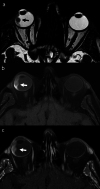Magnetism of materials: theory and practice in magnetic resonance imaging
- PMID: 34862955
- PMCID: PMC8643382
- DOI: 10.1186/s13244-021-01125-z
Magnetism of materials: theory and practice in magnetic resonance imaging
Abstract
All substances exert magnetic properties in some extent when placed in an external magnetic field. Magnetic susceptibility represents a measure of the magnitude of magnetization of a certain substance when the external magnetic field is applied. Depending on the tendency to be repelled or attracted by the magnetic field and in the latter case on the magnitude of this effect, materials can be classified as diamagnetic or paramagnetic, superparamagnetic and ferromagnetic, respectively. Knowledge of type and extent of susceptibility of common endogenous and exogenous substances and how their magnetic properties affect the conventional sequences used in magnetic resonance imaging (MRI) can help recognize them and exalt or minimize their presence in the acquired images, so as to improve diagnosis in a wide variety of benign and malignant diseases. Furthermore, in the context of diamagnetic susceptibility, chemical shift imaging enables to assess the intra-voxel ratio between water and fat content, analyzing the tissue composition of various organs and allowing a precise fat quantification. The following article reviews the fundamental physical principles of magnetic susceptibility and examines the magnetic properties of the principal endogenous and exogenous substances of interest in MRI, providing potential through representative cases for improved diagnosis in daily clinical routine.
Keywords: Artifact reduction; Chemical shift; Magnetic resonance imaging (MRI); Magnetic susceptibility.
© 2021. The Author(s).
Conflict of interest statement
The authors declare that they have no competing interest.
Figures
















References
-
- Halle B. Water in biological systems: the NMR picture. In: Bellissent-Funel MC, editor. Hydration processes in biology: theoretical and experimental approaches. Clifton: IOS Press; 1999. pp. 233–249.
Publication types
LinkOut - more resources
Full Text Sources

